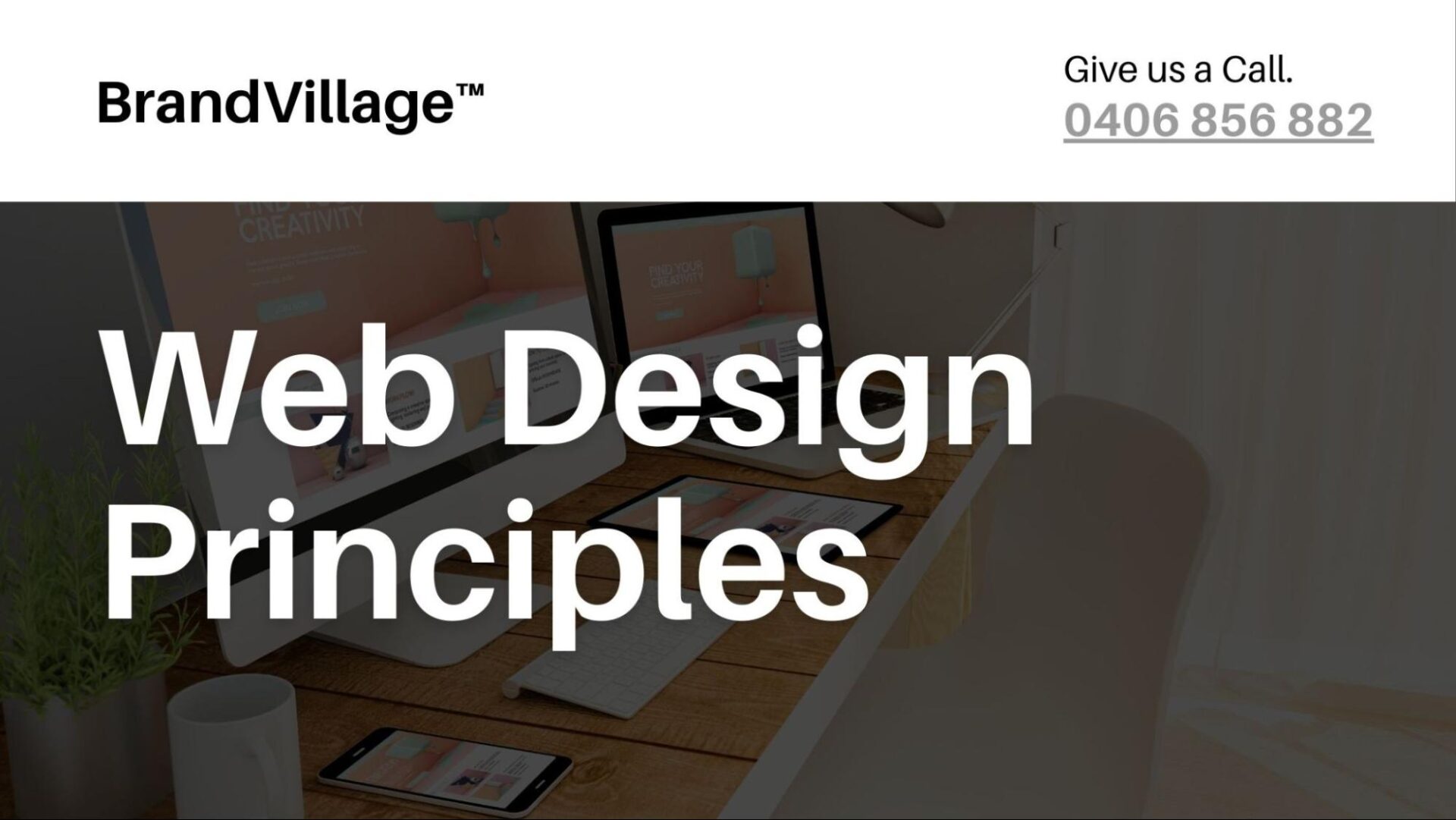Web Design Principles

Published: May 6, 2024
When it comes to creating a website that really connects with your audience, it’s crucial to understand and implement basic web design principles. This isn’t just about making a site that looks good—it’s about crafting an experience that feels intuitive, accessible, and engaging for your users. Think of your website as your digital front door; you want it to be welcoming, easy to navigate, and a reflection of what makes your brand special. In this guide, we’ll explore the core principles of web design that can help your website stand out and serve your visitors better. Our Designers at BrandVillage integrate these principles expertly in website designing, ensuring that each website not only captures the essence of the brand but also optimises user experience to maintain engagement and facilitate ease of use.
Understanding the Basics of Web Design

Web design is much more than just picking the right colours and fonts; it’s about the overall layout and functionality of your site. Every design choice should aim to improve user experience (UX) and ensure that visitors can find the information they need without hassle. From the structure of your navigation to the way your content is organised, every element plays a part in making your website effective.
26 Essential Web Design Principles
- Purpose and Clarity: Start by defining what your website aims to achieve. This clarity helps ensure that every element on your site serves a clear function, whether it’s to inform, entertain, or help visitors make a purchase. The clearer your purpose, the easier it is for visitors to understand and engage with your content.
- Hierarchy: This principle involves arranging elements in a way that reflects their importance. Use size, color, and placement to draw attention to key parts of your page. For example, larger, bolder text can indicate headings and guide visitors through your content in a logical order.
- Balance: Achieving visual balance makes your site more aesthetically pleasing and easier to navigate. Symmetry (mirroring elements on either side of a central line) creates a formal, organised look, while asymmetry can make a layout more dynamic and exciting.
- Contrast: Contrast helps make your content pop and guides the viewer’s focus to important sections. Using contrasting colors for background and text improves readability, and contrasting sizes can emphasise certain elements over others.
- Repetition: Consistency in design elements like colors, fonts, and button styles makes your site look professional and cohesive. This repetition helps create a rhythm and strengthens the overall design by tying together diverse sections visually.
- Alignment: Proper alignment of elements ensures your site looks organised and neat. Aligned text and images are easier to follow and create a smoother visual flow, helping visitors intuitively understand how to interact with your content.
- Proximity: Grouping related items together naturally suggests a relationship between them, which simplifies navigation and understanding. For example, placing a label next to its corresponding input field in a form makes it clear which text goes with which field.
- Simplicity: A simple design focuses on essential elements and avoids clutter. This doesn’t mean your site should lack character but that every element should serve a purpose, enhancing user experience without unnecessary distractions.
- Feedback: Interactive elements like forms and buttons should provide immediate feedback when interacted with. For instance, changing the color of a button when it’s clicked can reassure users that their action has been registered.
- Typography: The choice of typography affects both the aesthetics and readability of your site. Select fonts that are easy to read and appropriate for the tone of your content. Consistent use of font sizes and styles helps maintain clarity and hierarchy.
- Color Scheme: Colors can evoke emotions and set the tone of your website. Choosing the right color scheme helps reinforce your brand and makes your site visually appealing. Consider color psychology and accessibility to ensure your color choices are effective and inclusive.
- Flexibility: Designing your website to be flexible means it can adapt to different screen sizes and devices without losing functionality or aesthetic appeal. This involves using fluid grid layouts, flexible images, and media queries in CSS to ensure that your site looks great and functions well, whether it’s viewed on a desktop, a tablet, or a smartphone.
- Usability: Usability is about making your website easy for everyone to use. This includes having a logical structure, clear navigation, and interactive elements that are intuitive to use. Usability also involves ensuring that information is easy to access and that users can achieve their goals with minimal frustration.
- Navigation: Effective navigation should be intuitive and straightforward, helping users find what they need quickly without confusion. This involves having a well-organised menu, logical link placement, and a clear path back to the homepage. Including a search function can also enhance navigation, especially for larger sites.
- Accessibility: Accessibility means making your web content accessible to people with disabilities. This can include providing text alternatives for non-text content, making sure that all functionalities are available from a keyboard, and ensuring that users can access content in different ways, depending on their needs and preferences.
- Responsiveness: This is closely related to flexibility but focuses specifically on the layout and design automatically adjusting to fit the device it is viewed on. A responsive design ensures that no matter the device’s screen size, the website will maintain its usability and design integrity.
- Content Strategy: This involves planning, creating, and managing content in a way that supports the core goals of the site. Good content strategy aligns with the brand message, is targeted towards the site’s audience, and is optimised for search engines. It also considers how content will be structured and prioritised across the site.
- Load Time: Websites should load quickly to avoid user frustration and abandonment. This involves optimising image sizes, minifying CSS and JavaScript, and leveraging techniques such as caching and content delivery networks. Fast load times are also crucial for SEO as they are a factor in Google’s ranking algorithms.
- SEO Integration: Designing with SEO in mind includes using HTML and CSS that search engines can easily crawl, employing clear metadata and alt texts, and ensuring that the site architecture supports SEO strategies. This helps improve the site’s visibility and rankings in search engine results.
- Interactivity: Adding interactive elements to a website can significantly enhance user engagement. This might include things like hover effects, feedback forms, interactive infographics, and light animations. However, it’s important to balance interactivity with usability to ensure the site remains accessible and easy to use.
- Clear Calls to Action: Make it easy for visitors to know what to do next. Use buttons or links that stand out and tell them clearly what they will get, like “Buy Now,” “Learn More,” or “Sign Up.” This helps guide users towards taking action, such as buying a product or signing up for a newsletter.
- Speed Optimisation: Make sure your website loads fast. People don’t like to wait long for a page to open. By making your website faster, you help ensure that visitors will stay longer and have a better experience.
- Innovation: Staying updated with the latest design trends and technologies can give your site a competitive edge. While innovation means adopting new techniques and creative ideas, it should not compromise the site’s usability and core objectives.
- Consistency: Consistency in web design means keeping the look, feel, and overall structure of your site uniform. This makes it easier for users to understand how to navigate your site and what to expect as they explore different sections. Consistent use of color, typography, and layout helps strengthen the brand identity and improves the overall aesthetics.
- Branding: Effective branding in web design goes beyond just slapping your logo on every page. It involves a thoughtful integration of your brand’s colors, fonts, tone, and personality throughout the site. This creates a memorable experience for users and can distinguish your site from competitors.
- Mobile-first Design: Start designing your website for mobile phones first. More people use their phones to look at websites than computers. A mobile-first approach makes sure your website looks good and works well on small screens.
Each of these principles plays a crucial role in the design process, helping to create a website that is not only functional and user-friendly but also visually appealing and aligned with the brand’s goals. By carefully considering and implementing these principles, you can enhance the effectiveness of your website and ensure a better experience for your visitors.
Conclusion

Using these web design principles isn’t just to beautify your site; it’s about creating a welcoming environment where visitors can enjoy and easily navigate. By considering visitor preferences and selecting design elements thoughtfully, you can develop a website that truly resonates with your audience and remains effective over time. As a Melbourne design agency, BrandVillage excels in crafting forward-thinking branding strategies that anticipate customer needs, establishing robust and dynamic online identities.
FAQs
- What is the most important web design principle?
Purpose and Clarity is paramount because every element on your website should clearly support its overall goal, ensuring effective communication and user satisfaction.
- How do colour choices affect the user experience?
Colours influence emotions and behaviors; strategic use enhances focus, readability, and overall engagement, especially when ensuring sufficient contrast for accessibility.
- Why is mobile responsiveness so crucial in web design today?
With the increase in mobile usage, a responsive design ensures all users have a seamless experience regardless of device, crucial for broader accessibility and improved SEO.
- How can you ensure your website is accessible to everyone?
Implement key practices like providing alt text for images, enabling keyboard navigation, using readable fonts, avoiding seizure-triggering content, and maintaining clear navigation.
- What are some common mistakes in web design that can affect usability?
Some usual mistakes in web design that can make a site hard to use include using fancy fonts too much, not designing for mobile phones, having too many pop-ups, changing layouts too often, and having a website that loads slowly. These issues can make people less likely to stay on your site.
- How often should you update the design of your website?
You should think about updating your website’s design every 2 to 3 years. This keeps it up-to-date with the latest technology and what users expect. It also helps you use new ways to make the site easier to use and better for search engines.
Articles.

May 2024
How to Choose a Web Design Agency in Melbourne
Having a strong online presence is very important for any business in this digital...

May 2024
What is Web Design? Why is Web Design Important for a Business?
Web design is the art of creating websites. It’s not just about making sites...

May 2024
What does a Website Designer do?
Today, websites are very important for companies, creative people, and sharing information online. A...